At a Glance
Summary
ORIG3N’s ‘FITCODE’ test provided lots of detail about how my genetics linked to various aspects of fitness. I was impressed with how well referenced each result was and appreciated the extra features, such as the downloadable PDF report and the ability to sort the results by the gene tested.
It was, at times, difficult to make definitive conclusions, as often several same or very similar traits came out with apparently contradictory results. However, ORIG3N did explain this in their FAQ section and it helped me to understand how many genes can contribute to one trait. Overall, it provided interesting information and some specific advice, though sometimes it was difficult to work out which of this to follow. I’d recommend it as a useful tool for those looking for insights with which to independently develop a personalized fitness routine.
Full Review
'FITCODE' is one of several DNA tests offered by ORIG3N, a company based in Boston, USA. Founded by Robin Smith and Kate Blanchard in 2014, the company is focused on helping to promote and develop personalized approaches to healthcare, using DNA tests and research into stem cell treatments. In addition to FITCODE, ORIG3N offers tests that report on nutrition, skin characteristics, behavior, child development and even whether you have any superhero traits!
Having already tried out a few of these options, I wanted to see how well FITCODE would compare in the increasingly competitive fitness DNA testing market.
Product Expectations
The ORIG3N website homepage was bright and welcoming. There was a page dedicated to the FITCODE test which revealed that it would analyze 27 genes, to report on six areas of fitness. I read that the information I’d receive was designed to help me to fine tune my exercise routine and reach my goals more quickly. I was impressed to see that in addition to details of the traits that would be reported on, I was able to view a list of the specific genes that would be analyzed to do so.
Several images accompanied the description, showing the kit, its contents, and some sample results. There was also a ‘How it works’ section, which provided a basic and straightforward overview of the process. This linked to a full page that provided further, more detailed information about how the testing would work.
In addition to the process, this page included details about the lab and the privacy of my genetic data. I was also interested to read that, should I want to take more ORIG3N tests later on, I wouldn’t need to submit another sample, as they could use the data from the one I provided this time.
Looking at the privacy policy, I was initially impressed to read that my genetic data wouldn’t be used for anything other than the service I purchased, without my consent. However, reading on, I was concerned to find out that if I did consent to sharing my data with ORIG3N, they had the right to use it in absolutely any way that they wished. I wouldn’t be able to withdraw my consent or even be informed about how my data was being used.
This was worrying, but I appreciated that I was not automatically opted in and was pleased to see that they had included exactly how this consent would be asked for (via a popup). Knowing what to watch out for was helpful and reassured me that I wouldn’t opt in accidentally.
Ordering Experience
The FITCODE test was easy to order. I added it to my cart, entered my email and shipping addresses, and was pleased to see that standard shipping was free, but that I could also upgrade to 2 day and overnight FedEx options if I wanted. I paid with my credit card (this was the only option in terms of payment) and got an email confirming my order.
I received the kit about a week later and was pleased to find that it looked as good as it had on the website – I would have been happy to give it as a gift. The instructions were straightforward, and the swab was easy to use. The whole process took less than 5 minutes and I was grateful that the return postage was included, meaning I could just pop it in the post. I received an email confirming it had reached the lab and was being processed.
The Results
I was pleased to get my results only a week after I’d received this email, which was much earlier than had been estimated on the website. I was notified via another email, which prompted me to log in to the account I’d created when registering my kit. Here, I found a dashboard of all the tests ORIG3N offered, with the ones I hadn’t taken greyed out. I clicked on FITCODE to open a menu of five sections: ‘Exercise Recovery’, ‘Metabolism’, ‘Joints’, ‘Endurance’ and ‘Power Performance’ (shown below).

The dashboard, showing the different categories of results.
I was surprised to find that there was no ‘Muscle Strength’ section, despite this being included in the product description on the ORIG3N website. Above this menu there was a box that detailed the name of the test, my sample I.D. and a link that allowed me to download a PDF of the report to read offline.
Results Section: PDF Version
I was pleased to have this option, and was intrigued about whether ‘Muscle Strength’ would be included in this version. Looking at the front page (shown below), I noticed that it had been included in the list of categories. However, scrolling through the report, I realized there weren’t actually any results included for this section.
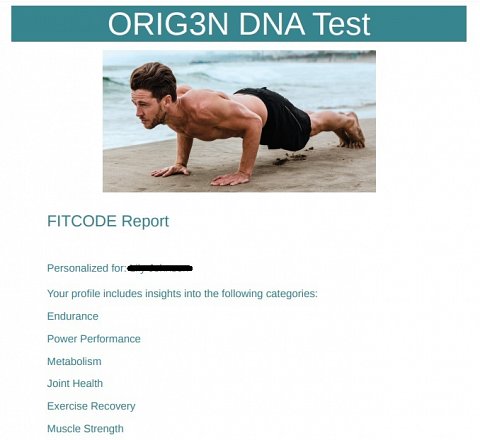
The front page of the PDF version of my FITCODE report.
Aside from this, the reports were very similar. The only major differences that I noticed were that the PDF document had a more basic, yet formal look and just used two letter results, whereas the online version used a system of assigning the results as either ‘Adapt’, ‘Normal’ or ‘Gifted’, in addition to these letters.
Results Section: Endurance
Having looked at both versions of the reports, I decided that the online one seemed easier to navigate and explore. I looked first at the ‘Endurance’ category, which included seven results. As previously mentioned, this online version used a system of assigning each result a label of ‘Adapt’, ‘Normal’ or ‘Gifted’ (shown below).
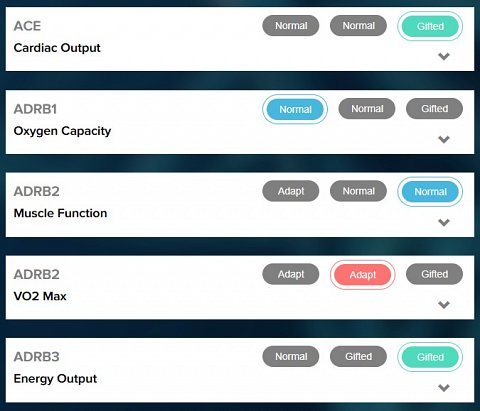
A selection of my Endurance results.
I was interested to see that, for some of the results, there was more than one of each option. For example, for a few results, there were two possibilities of the outcome being ‘Gifted’, one of it being ‘Normal’, but no possibility of an ‘Adapt’ outcome. I hoped that there might be some explanation about why this was, or clarification of exactly what these labels meant in practical terms, but unfortunately, I couldn’t find any.
I was able to see more information about each result by clicking on the downward-pointing arrow, which expanded it. My ‘VO2 Max’ and ‘Muscle Efficiency’ results were ‘Adapt’. I guessed that this meant that these were the areas that I would have to work harder in, as these were also marked in red. I looked at these in more detail with the hope that I could find ways to overcome them.
My VO2 Max result was the first I looked at in detail, and when I expanded it I saw that there were three tabs. Mine was labelled ‘AG’ and the others were labelled ‘AA’ and ‘GG’ (shown below).

My VO2 Max result.
These tabs contained explanations of the results, split into two sections. The first seemed to be focused on advice related to my result, whereas the second part, which had a ‘Comments’ subtitle, provided more about the science behind it. I was impressed by the specificity of the advice, such as the recommendation that I do ‘Workouts that have 30 seconds of work followed by a minute of rest.’. I also learnt that my result was associated with less endurance and more power, but still wasn’t sure exactly what VO2 Max was, even after reading through all the information.
After looking it up myself, I was surprised to read that it indicated someone’s maximum oxygen intake when exercising, as this hadn’t been mentioned at all in the explanation and there was a separate result for ‘Oxygen Consumption’ for which I had received a ‘Normal’ result.
I was happy to see that out of the seven results, three were ‘Gifted’, and two were ‘Normal’. Looking at my ‘Energy Output’ result in more detail, I read that my version of the gene was only found in around 20% of the population, and is particularly common in world class runners and cyclists. This came as a bit of a surprise, as I’ve never been drawn to running as a way of keeping fit, but would definitely consider it now. The specific recommendation that I do 30-45 minutes of exercise with little rest, due to being more likely to excel at endurance, gave me even more reason to give it a go.
However, when looking at another of my ‘Gifted’ results, ‘Cardiac Output’, I was surprised to read that this was associated with lower endurance and higher strength, which seemed to contradict the previous finding. Luckily, I noticed a link to FAQs at the bottom of the page, which included an explanation. I learnt that it was quite normal to have contradicting results and that in reality I was likely to display an average of the two. Whilst I was grateful for this explanation, it had taken me a while to find and I still wasn’t quite sure why the results contradicted each other.
The rest of my results included ‘Muscle Function’ and ‘Aerobic Fitness’ which both suggested stronger endurance, and ‘Muscle Efficiency’, which was associated with lower endurance. Although I understood that my overall endurance was an average of all these results, having looked through the whole section, I was still not sure whether I should focus on endurance or power exercises.
Results Section: Power Performance
The next section of the report, ‘Power Performance’, was a bit easier to make conclusions from. It included only three traits, ‘Muscle Strength’, ‘Strength Building’ and ‘Blood Flow Regulation’. I was happy to see that my result for each of them was ‘Gifted’. This seemed to clearly indicate that I was more likely to excel in strength-based exercises, and there were specific suggestions, such as rowing and high-intensity interval training.
Results Section: Metabolism
The ‘Metabolism’ section of the report also included three traits, ‘Fat Processing Ability’, ‘Feeling Full’ and ‘Monounsaturated Fat’. I was happy to read that although the first of these was ‘Normal’, this indicated a lower risk of obesity. However, the other two results were ‘Adapt’, meaning that I was likely to have a higher appetite and might not metabolize fats as well as others, both resulting in a tendency to gain weight easily.
Although this was slightly disheartening, I was impressed by the very specific advice that was provided to combat these issues. For my Feeling Full result, it not only advised me to eat less quickly, but suggested that I do this by putting down my fork between taking bites of my meals. Despite being such a simple tip, it was quick to implement, and I’ve noticed that it’s already made a difference to how much I eat. It has also made eating more sociable, as I no longer just focus on chowing down my food as quickly as possible!
Results Section: Joint Health
The ‘Joint Health’ section was the smallest in the report, with two results. The first of these was ‘Joint Strength and Flexibility’ which came out as ‘Gifted’, suggesting I was less prone to tendon injury specifically. However, my ‘Adapt’ result for ‘Joint Health and Injury’ suggested the opposite. I guessed I should be wary of joint injury, but not overly worried about it. Luckily, similar advice was provided for both results and it pointed out that a lot of non-genetic factors influenced how likely I was to get injured, for example by wearing inappropriate footwear or exercising after muscles are fatigued.
Results Section: Exercise Recovery
The ‘Exercise Recovery’ section offered further advice about how to properly recover from workouts in order to reduce the risk of injury. Two of these results came back as ‘Normal’ and one as ‘Gifted’ which was reassuring. I found that this section had the most specific advice, including a list of foods to eat more to improve my anti-oxidant protection.
Results Section: Genes
The final section I looked at was not part of the main report, but provided another way in which to look through the information. The ‘Genes’ feature allowed me to sort the results by the genes analyzed, rather than the traits they were associated with. A selection is shown below.
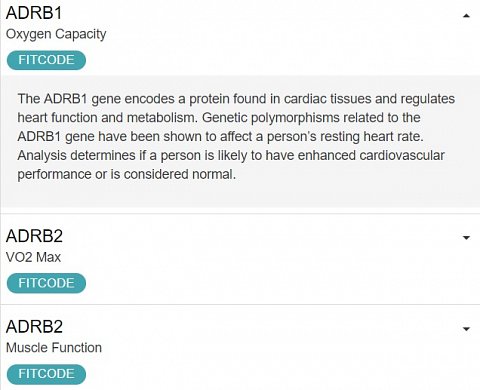
Some of my results sorted by the genes analyzed.
They were sorted alphabetically, making it easy to search for specific genes. Even though I wasn’t familiar enough with genetics to really need this feature, I thought it was great that it had been included.
Summary
ORIG3N’s ‘FITCODE’ test provided lots of detail about how my genetics linked to various aspects of fitness. I was impressed with how well referenced each result was and appreciated the extra features, such as the downloadable PDF report and the ability to sort the results by the gene tested.
It was, at times, difficult to make definitive conclusions, as often several same or very similar traits came out with apparently contradictory results. However, ORIG3N did explain this in their FAQ section and it helped me to understand how many genes can contribute to one trait. Overall, it provided interesting information and some specific advice, though sometimes it was difficult to work out which of this to follow. I’d recommend it as a useful tool for those looking for insights with which to independently develop a personalized fitness routine.
Please note that this test may have changed since our review was written. To ensure you know what to expect from this test, please check the company's website.
At a Glance
Summary
Overall, ORIG3N's 'NUTRITION' report provided me with a lot of interesting and useful information about my diet. Although I found some of my results were contradictory, I came away with a good idea of what I need to be cautious of, and what I can be a little less concerned about when planning my diet.
I felt I was given a unique insight into what I should be taking into consideration, and was glad to have a couple of pieces of specific, personalized advice to use moving forward. Although these recommendations might not be enough for those looking for a quick, specific, and immediately implementable diet plan, I would definitely recommend this test to those looking for a tool to help them develop their own, more personalized diet.
Full Review
ORIG3N is an American biotech start-up founded in 2014, Boston, MA. Headed by Robin Smith, the company specializes in the research of pioneering treatments for genetic conditions, but also aims to use DNA tests as a way of empowering people to take charge of their health. Although this is the company’s primary focus, their tests offer customers a range of information about themselves. They use DNA to report on diet and fitness, predict your likely behavior (BLISS), assess your skin characteristics and even highlight any ‘superhero’ traits you’re likely to exhibit. I was excited to find out how the NUTRITION test would help me to find out about what I should and shouldn’t be including in my diet, according to my DNA.
Product Expectations
The ORIG3N website looked very sleek and was easy to use. The NUTRITION test had its own product page and was described as a DNA test “designed to reveal which foods work best for you, what to avoid, and what might make you feel better”. I read that the NUTRITION test would report on 24 genes in four different categories: ’Food Sensitivity’, ‘Food Breakdown’, ‘Hunger and Weight’ and ‘Vitamins’ . I was pleased to see all the genetic traits that would be screened for within these categories were listed, which ranged from 'Lactose Intolerance' to 'Aversion to Cilantro'. I was also impressed to see that for each, the gene that would be analyzed to report on it was also provided
The process of testing was explained in a ‘How it works’ section at the bottom of the product page, with symbols illustrating each step. This included a link to a full How it works page, which provided further details about the process, as well as sample instructions and pictures of the kit, a link to the registration page and information about the privacy of my data. This helped to make everything seem less daunting and I looked forward to finding out more about the links between my DNA and my diet.
Ordering Experience
Whilst looking through the ORIG3N website, I had been impressed to see several assurances about the privacy of my data. This was confirmed in the privacy policy, which explained that I was the sole owner of my genetic information, and that my data would be kept private unless I consented to Orig3n using it. However, I was surprised and a bit alarmed to read that if I consented to ORIG3N using my DNA for research, I would have no say over what happened to it, would not be able to revoke my consent and ORIG3N would be able to use it in whichever way they liked.
Although this was initially alarming, the policy described exactly how they would ask for this consent (“via a popup screen within the Apps”), so I was reassured that as long as I was careful, I wouldn’t accidentally provide this consent.
I ordered my NUTRITION test online with a credit card, which was the only payment method offered, and received my kit a few days later. It was very nicely put together, and looked like the pictures I’d seen on the website. My registration code was on a card on the box, and this, in addition to my email address, was all I needed to set up my account online.
All the instructions I’d seen on the website were also included in the kit, and taking the sample with the cotton cheek swab was quick and easy.
I was happy to see that return postage was free, making it easy to send my sample back to ORIG3N’s lab. Soon afterwards, I received an email confirming that my samples had arrived.
The Results
My results were ready just one week after I had sent my sample off, which was much quicker than the website had predicted. I received an email notifying me that they were available, and logged into my account to access them. I clicked on the NUTRITION option to find four icons (shown below) for the different results sections: 'Food Sensitivity', 'Food Breakdown', 'Hunger and Weight' and ‘Vitamins’.

Three of the four sections of my NUTRITION report.
Above these categories, there was a box that included the name of the test, my sample I.D., and the option to download the report as a PDF.
Results Section: Food Sensitivity
The first section of results I looked at was Food Sensitivity, where I found seven traits were listed under a heading and a brief introductory sentence. Next to each trait was a row of three results, and it was obvious that mine was the one highlighted with color (shown below).

A selection of my Food Sensitivity results.
Unfortunately, I was unable to find anything that explained exactly what ‘Adapt’, ‘Normal’ and ‘Gifted’ meant. However, since all my ‘Adapt’ results were highlighted in red, I assumed these were the bad ones, while the ‘Gifted’ results highlighted green were good, and the ‘Normal’ results in blue were neutral.
I saw that my result for 'CYP1A2 Caffeine Metabolism' was ‘Adapt’. I clicked the downwards arrow to find the result expanded into a more detailed explanation.
There were three of these explanations, and the tab for my result was in was labelled 'CC' (shown below).

My Caffeine Metabolism result.
Reading through the explanation, I learnt that CC was the version of the gene 'CYP1A2' that I carried. The other two, labelled ‘AC’ and ‘AA’, included explanations of the other two possible results, which were interesting to compare to my own.
My result explanation told me that this was quite rare, and that only about 15% of the population possessed this form of the gene. Having these percentages, which were included for all of the results, made it a lot easier to put the outcomes in context.
I read on, to find that this result was associated with a relatively slow caffeine metabolism. I was impressed to find a 'Click to see references' section after each result, which linked me to scientific papers backing up the association between the gene and the trait.
It was useful to know that I was genetically likely to keep caffeine in my system for longer, and that this makes me more susceptible to nervousness, increased heart rate, irritability, insomnia, and increased risk of cardiovascular disease. I've often found that if I drink coffee too late in the day I have trouble sleeping at night, and this was a good enough reason for me to break the habit.
Under a ‘Comments’ sub-title, further explanation linked the result to advice and scientific details about the trait. For my Caffeine Metabolism result, it explained how the effects of caffeine are caused and why these would likely last longer for me. I was advised that I shouldn't consume it in large amounts and some sources of caffeine were provided to help me.
In the Lactose Intolerance result I was unsurprised and, as a cheese lover, relieved to find out that I’m likely to be able to digest dairy products throughout my life.
However, I was surprised to see that my result for 'Cilantro Aversion' showed I was more likely to enjoy this herb. I've never liked cilantro, so I suppose now I can just put that down to being a fussy eater!
I also saw that there were three separate results called 'Bitter Taste', all of which came back as 'Gifted', meaning I was likely to be sensitive to bitter foods. In the explanation, cabbage, broccoli, cauliflower, kale, brussel sprouts, and collard greens were listed as foods I was likely to find bitter. Because these all have excellent health benefits, it was suggested that I use herbs and spices to counter the bitter taste and still get the benefits, which I thought was a useful and personalized tip.
Results Section: Food Breakdown
Food Breakdown was the shortest section in the report, with only three results listed. 'Fatty Acid Response' was the first, and I saw that my result was ‘Adapt’. I felt a little better about this when I expanded the result and saw that this placed me in 44% of the population who were also likely to have higher cholesterol. Fortunately, my next result, 'Cholesterol and Lipids', was ‘Normal’, and showed that I had a version of the gene associated with having the LDL kind of cholesterol, which is less harmful.
My last result in this section was for 'Monounsaturated fat', which was ‘Adapt’. I was told that I should be mindful of the kinds of fat I consume as my genetics make me more likely to metabolize certain types of fat poorly, which often leads to weight gain. I was given a helpful list of foods I could find healthy fats in, which included nuts, seeds, oils, avocado and fish rich in omega-3 fatty acids. I was also told to limit fried foods and high-fat meat and dairy products. Although this was advice I'd heard before, knowing it was directly targeted at my genetic information definitely gave it more weight.
Results Section: Hunger and Weight
I decided to look at the Hunger and Weight section in the downloadable PDF version of the report. The front cover is shown below.
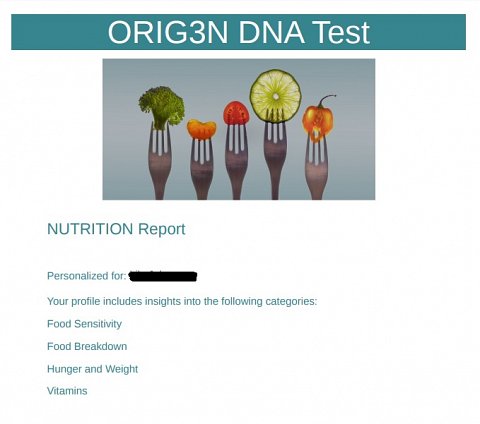
The front cover of the PDF version of my report.
I liked that this included a clear list of the different sections and the image added some color, but overall, the format of this version of the report was much more simplistic than the online one.
In terms of the content, the main difference I noticed was that the results weren’t marked as ‘Adapt’, ‘Normal’ or ‘Gifted’ and instead just reported which form of the gene I had. Other than that, the information seemed identical to the information provided in the online version.
Reading through, my 'Sweet Tooth' result (shown below) caught my eye, and revealed that I’m part of 20% of the population that are more likely to enjoy sweet food. I can't say this result was a shock, but I was surprised that we make up only 20% of the population!
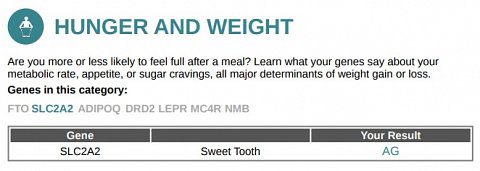
My Sweet Tooth result in the PDF version of the report.
It was recommended that I create nutrient rich meals for myself, and try to stay away from sugary drinks and foods, like candy, cakes, cookies, as well as less obvious things, for example salad dressings.
Looking back at the online version, I noticed that in this section, there weren’t any results where it was possible to be ‘Gifted’, so I was quite pleased that most of my results were ‘Normal’. One example was 'Food Reward', and although I was glad to read that I was less prone to addictive behavior, I have been known to polish off a box of cookies in one sitting, so wasn’t sure how accurate this was. Some light was shed on this when I saw that my next result, 'Feeling Full' was highlighted red as ‘Adapt’.
It was interesting to learn that I was less likely to feel full after a meal, and I think it shifted my perspective on how I eat. I was given the advice to eat meals at a slower pace, chewing completely and putting down my fork between bites. Now I knew that I was genetically predisposed to eating sugary foods, even after I was full, I could specifically target these bad habits to keep myself as healthy as possible.
Results Section: Vitamins
I recognized many of the vitamins in the Vitamins results section, but had never really known why they were important. I saw that my first two results were the only ones highlighted red. The first was 'Beta Carotene, Vitamin A', and when I clicked to see more explanation, I found that I was among the minority (5% of the population) who have a reduced conversion of beta carotene into retinol. I was provided with a list of foods rich in vitamin A to help remedy this, some more appealing than others, including carrots, kale, mango, and liver.
I learnt from the Comments section that vitamin A plays an important role in bone growth, vision, reproduction, and immunity. It was recommended that I take a vitamin A supplement, but with a warning that it can be toxic when consumed in excessive amounts. I was glad there was some explanation, as well as some advice.
My other ‘Adapt’ result was ‘Vitamin B12’, and I discovered that this was much more common, with 50% of the population carrying the same variation of the gene. The Comments section explained that vitamin B12 plays an essential role in the functioning of the brain, the nervous system, and the formation of red blood cells.
It also provided a list of foods I could find vitamin B12 in, such as dairy, fish, poultry, and meat. These all seemed easy to incorporate into my diet, along with some of the other recommendations, and I was excited to get started on my new, personalized diet plan with the information I now had.
Summary
Overall, ORIG3N's 'NUTRITION' report provided me with a lot of interesting and useful information about my diet. Although I found some of my results were contradictory, I came away with a good idea of what I need to be cautious of, and what I can be a little less concerned about when planning my diet.
I felt I was given a unique insight into what I should be taking into consideration, and was glad to have a couple of pieces of specific, personalized advice to use moving forward. Although these recommendations might not be enough for those looking for a quick, specific, and immediately implementable diet plan, I would definitely recommend this test to those looking for a tool to help them develop their own, more personalized diet.
Please note that this test may have changed since our review was written. To ensure you know what to expect from this test, please check the company's website.


